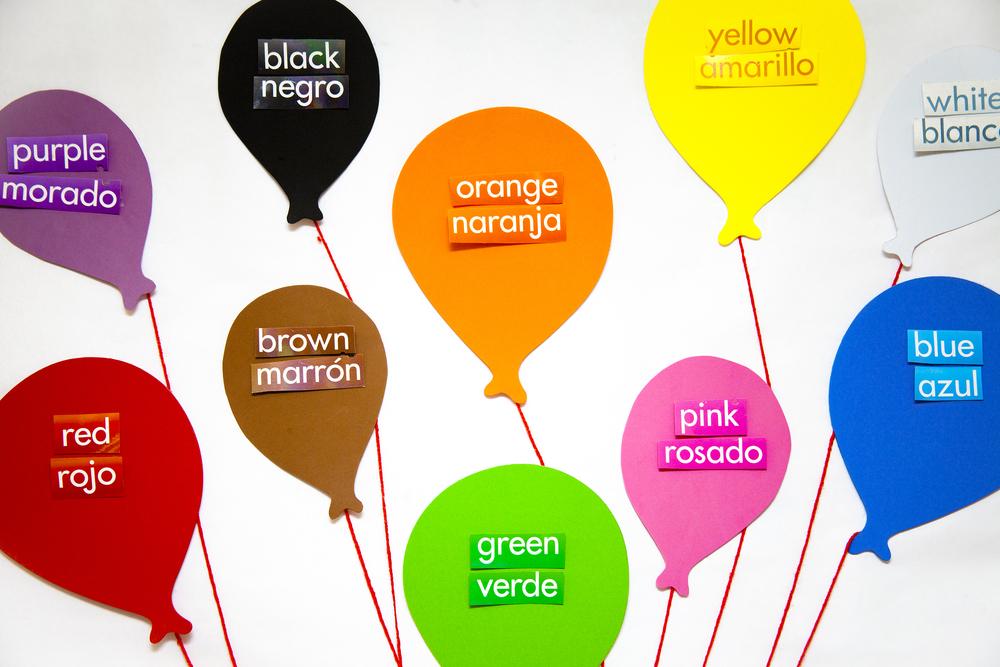There are several advantages to exposing youngsters to Spanish colors. People often assume that youngsters have a natural advantage when picking up foreign languages. When your child is in their language development, it is the moment to instill the desire to learn a second language.
There’s nothing wrong with starting with particular topics and essential words if you want to pique your child’s interest and boost their confidence in their language-learning abilities. The study of color names in Spanish may be both fun and straightforward.

The Spanish Language Is Rich in Colors
How do you say “colors” when speaking Spanish?
We call it : Los colores.
It is common to use the terms coloreado and colorido interchangeably to refer to anything colored. To paraphrase Johann Wolfgang von Goethe, “colors are feelings produced by light beams that impact visually and rely on the wavelength of such rays” (teora del color).
Color is defined as “perception” by color theorists like Goethe. Objects can take in specific frequencies of light and emit them at another time. The other, non-absorbing segments convey various stimuli that collectively create a subjective experience of color. Every language relies heavily on the use of color. Their descriptions of things, locations, animals, and human anatomy are spot-on.
The Color Scheme Wheel in Spanish
The Spanish color wheel, or El Circulo cromático, presents the colors in a coherent, interrelated form that is helpful when learning about colors in Spanish. The Spanish color wheel relates the 11 colors and their various shades.
The six primary hues comprise the foundation of the Spanish color chart known as El Circulo cromático.
- Morado (purple) (purple)
- Rojo (red) (red)
- Amarillo (yellow) (yellow)
- Azul cian (cyan blue)
- Azul oscuro (dark blue)
- Verde (green) (green)
Colores cálidos (warm colors) and colores fríos (cool colors) make up half of the Spanish color wheel (warm colors and cold colors). Visual artists and graphic designers might also benefit from referring to a Spanish color chart like this. It captures the balance and contrast that can be achieved between color tones.
Marketers can benefit significantly from a Spanish color chart, including visual merchandisers, decorators, event planners, fashion designers, and others.
Colors and Their Descriptions
Colors are a valuable group of adjectives describing the various things, locations, plants, and animals humans meet daily. Writers and speakers frequently use color to convey the whole range of an object’s qualities in a reader’s or listener’s mind. Similarly, painters frequently use a wide range of hues while creating an image with paint, colored pencils, or watercolors.
Some standard primary colors are red, yellow, blue, orange, green, and purpose. Colors are typically broken down into warm, cold, and neutral groups by artists and scientists alike. Pink, red, yellow, and orange are warm colors since they give off a more upbeat and welcoming vibe than their cooler counterparts, the blues and purples. The effect of cool hues is more soothing and mellow than that of warm ones. White, grey, black, and brown are neutral colors that work well with warm and cool hues.
Colores fros (cold colors) in Spanish.
Colors A through H on the color wheel are all termed colores frios (cold colors):
- Violeta (Violet) (Violet)
- Azul-Violeta (Violet with more blue)
- Verde (Green)
- Amarillo-Verde (green with more yellow)
- Azul-Verde (Green with more blue)
Colores frios evoke a sense of tranquility and cold but also despair and indifference. Cold colors, or colores fros, are often utilized in creation to create the visual sense of distance.
Colores cálidos (Warm colors) in Spanish.
Colors considered colores cálidos across the board are:
- Naranja (Orange)
- Rojo-naranja ( Orange with more)
- Naranja-Amarillo ( yellow with more orange)
- Amarillo (Yellow)
- Rojo (Red)
- Rojo-Violeta (Violet with more red)
Warm and welcoming but sometimes angry and hostile, calid colors are known as colores cálidos. The opposite of cold hues, warm colors provide the sense that an object is closer to the spectator.
Colores neutres (Neutral or Discreet Colors) in Spanish
This table lists neutral colors, sometimes known as colores neutres. Understand that different shades of brown have other names in Spanish. It’s not uncommon for a multi-hued palette to serve as a descriptor of an object. A dash between two colors denotes a color combination in English; for example, “red-brown.” The Spanish language follows the same pattern to describe a variety of two colors. Blue-green, for instance, is Azul-Verde in Spanish, whereas red-brown is Rojo-marrón.
Spanish Color Grammar Colors serve several purposes. A noun or subject can be described with an adverb, such as “la casa rose” (The pink house). Colors can stand in for people and things when used as nouns; me gusta la Amarilla (I like yellow). Last but not least, Spanish speakers can utilize hues as verbs, as in “la casa is Verde” (the house is green) or “the kid overate. Thus her face is green” (The girl ate too much, now her face is green).
Uses of Color in Spanish
Nouns
A color can function as a noun when directed to an object or an individual. Colors are never feminine nouns, even when they finish with the feminine -a suffix. In most cases, nouns take their names from the color of their subjects. You get the idea, and they are all types of plants, flowers, and fruits.
Some nouns that derive their names from their colors are:
- Naranja (an orange)
- Canela (Cinnamon)
Verbs
The Spanish verbs ester or ser, meaning “to be,” are used in conjunction with colors when the latter are used as verbs. As a quick summary, ser is for the explanation of anything that will always have that color (like blue eyes), while estar is used for explaining something that will only have that color temporarily.
Another area prone to misunderstanding is learning the difference between Ser and Estar in Spanish.
Here are some sample sentences:
- La cosa azul no debería eztar ahí (there should be no blue thing)
- El búho es blanco (The owl is white)
Adjectives
When describing a word or subject, colors function as adjectives. Bloom, an adjective, is typically placed after the noun it describes.
Verb + Noun + Adjective (color)
In Spanish, the phrase “the white rabbit” would be written as “El (adverb) Conejo (noun) Blanco” (adjective). That’s the correct way to utilize adjectives in Spanish. Because Spanish adjective usage differs slightly from English, familiarizing yourself with the subject will help you communicate more effectively in the language.
Here are some sample sentences:
- Green Book (The green book)
- Slang for the yellow lizard (The yellow bow
Agreement of Gender
Adjectives describing spanish colors must relate to the nouns they modify in gender and number.
The male -o-ending hues will likely be rendered in the feminine-a form. Compound colors would be an exception to this rule.
Here are some sample sentences:
- Amarillo (Yellow)
- La mesa Amarilla (The yellow chair)
- La camiso camarillo (The yellow shirt)
- Rojo (Red) (Red)
- La manzana roja (The red apple)
- El frijol rojo (The red bean)
Why bother learning the Spanish names for every shade?
Before starting, we need to ensure you’re down with learning the spectrum. You may have assumed that learning the colors was inevitable, but we have some excellent reasons why you should make it a top priority right now, no issue where you are in your learning process.
Use more precise language.
You’ll be able to express yourself more precisely if you’re familiar with the nuances of color. Perhaps it’s not just any old salsa you’re craving for your tacos, but some spicy salsa verde. The ability to accurately describe anything with a color descriptor is a powerful tool.
Add some vibrancy to your studies.
Yes, it does have a slightly cheesy ring to it. I know it seems crazy, but that’s the truth. Colorful sentences are a fantastic way to get kids interested in learning Spanish. If you’re learning Spanish for kids, you’ll find that learning to utilize color in your phrases is a genius way to get them involved in the language.
Because Clifford is more than a large, big red dog, that’s what he is. The same holds for other fictitious characters and story titles, such as the Pink Panther and Dr. Seuss’s Green Eggs & Ham. Using all the crayons in the box to color your phrases will offer a new dimension to your story.
Determine the identity of mysterious items.
Among the many advantages of learning the Spanish colors early on is this. Help is needed to determine the nature of an unknown object. Precisely what is that red item over there called? Don’t hesitate to contact a serving of the coral-colored variety.
In the right hands, this method can aid in acquiring often encountered language. You were careful not to let this become a crutch. Do not mistake repeatedly requesting the yellow fruit at the grocery store.
Tips on How to Teach The Spanish Colors
Most kids of any age would pronounce the words aloud rather than look at the index cards, especially with smaller kids. You might need to get crafty if you want to educate them on the Spanish names of the various hues. To avoid overwhelming your toddler, it’s preferable to introduce only a few colors at a time. To successfully educate them, consistency is crucial. Some sneaky approaches to teaching kids the Spanish names for each color are provided below.
- In Spanish, you can state the word for the color without translating it. For example, when you give someone an orange, you can say Naranja or anaranjado to describe the fruit’s hue. One day, your child will connect the Spanish word with the English one.
- One fun way to introduce Spanish colors to your children is to play a color game. Color bingo is possible in which players fill off squares as they hear the name of a pigment called out in Spanish. Or veo (Color). In my mind’s eye, I’m seeing a specific hue. And they need to deduce the subject of your gaze. The equivalent of “I spy!”
- Give those to kids if you can find crayons with both Spanish and English labels. You can get one for your kid and use it to discuss the different colors. This will also show them how their names are spelled.
- Take a look at some videos on YouTube — there, you may find songs that will help you educate your kids on the colors. Music is a powerful tool for teaching some concepts to young learners. Most mature people do, after all.
- Children will like coloring whatever you give them, and you may use that fact to your advantage by giving them educational material. You can tell them what color something should be in Spanish orally or by writing it down on the page.
You are generally progressing toward the goal of becoming fully multilingual. Do not hesitate to refer back to this color vocabulary reference in Spanish as frequently as you feel is necessary. Because of the wide range of people with whom Spanish speakers can communicate, as well as the ease with which they can travel throughout Latin America, the Spanish language has become an indispensable tool for global commerce and communication.





